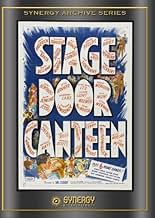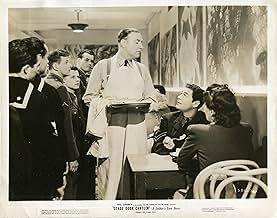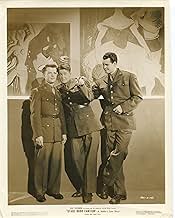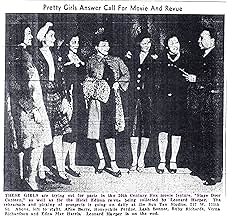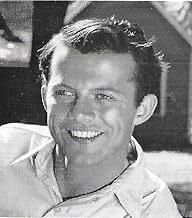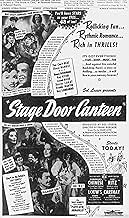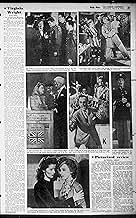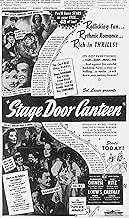Ajouter une intrigue dans votre langueA young soldier arrives in NYC and, before heading overseas to WWII, visits Stage Door Canteen, where famous actresses and entertainers volunteer to entertain soldiers.A young soldier arrives in NYC and, before heading overseas to WWII, visits Stage Door Canteen, where famous actresses and entertainers volunteer to entertain soldiers.A young soldier arrives in NYC and, before heading overseas to WWII, visits Stage Door Canteen, where famous actresses and entertainers volunteer to entertain soldiers.
- Réalisation
- Scénario
- Casting principal
- Nommé pour 2 Oscars
- 1 victoire et 2 nominations au total
Avis à la une
The film is chock-full of celebrity cameos by dozens of famous stars of the stage, screen, and radio. Most of the celebrities are identified in some way, although big-time classic movie fans should have fun spotting them first.
The movie is a product of its time, and seen many decades removed from its original context it becomes something of a time capsule, showcasing the entertainment of a past generation. Some of the names will be a bit obscure to modern audiences (particularly stage stars who didn't make many movies).* Guest stars include ventriloquist Edgar Bergen, vaudeville comedian Ed Wynn, Oscar-winners Katharine Hepburn and Paul Muni, the jazz bands of Benny Goodman and Count Basie, and various Hollywood supporting players and entertainment personalities.
Where else can you see Franklin Pangborn wash dishes with jungle man Johnny Weissmuller? Other highlights are scenes between married Broadway stars Alfred Lunt and Lynn Fontanne, a rousing song by Ethel Merman, and a comic striptease by Gypsy Rose Lee (strictly rated G -- more "tease" than "strip").
Classic movie fans will get more out of this film than the uninitiated, who might not recognize the faces or even the names that go with them. The movie works best when you can appreciate the cameos.
Don't expect much in the way of plot. Comedy bits and musical numbers are strung together by a story of young soldiers visiting the Canteen on leave before being shipped overseas and the girls they meet inside. The young romances reflect the bittersweet reality of wartime relationships.
Cheryl Walker is lovely as the ice queen hostess who comes to the Canteen for all the wrong reasons. She's looking to further her own acting career and isn't particularly interested in showing the soldiers a good time. Marjorie Riordan is cute as one of the other hostesses, who spends time with a soldier who has no sweetheart back home.
STAGE DOOR CANTEEN isn't wartime escapism. Director Frank Borzage doesn't try to distract the audience from the global situation. He keeps the audience constantly reminded, with the soldiers, sailors, airmen, and Marines that populate the Canteen and the alternately upbeat and somber patriotic tunes. Amid all the star-gazing, the film comes out in support of the U.S. servicemen, as well as America's allies in combat from Australia, the U.K., Russia, and even China. It's not hard to imagine the comfort the film must have given audiences at the height of World War II.
*The similarly-themed HOLLYWOOD_CANTEEN (1944) may have more recognizable stars, boasting some of the biggest names from Warner Bros. films (Bette Davis, Joan Leslie, Joan Crawford, John Garfield, S.Z. Sakall, Ida Lupino, Jack Carson, Sydney Greenstreet, Jane Wyman, etc.).
No reason it can't be enjoyed though. Skip the slight plot involving the servicemen who are patronizing the Stage Door Canteen who hook up with the hostesses there. Concentrate on the number of stars in the film, each doing some bit of business for themselves.
Though a number of film stars are here, the film concentrates on stars of the Broadway stage. Katherine Cornell makes her one and only appearance in a film, in fact my favorite part of Stage Door Canteen is her impromptu reading from Romeo and Juliet with bashful GI Lon McCallister who played Romeo in high school. Alfred Lunt and Lynne Fontanne are here also. The Lunts later did some televised plays and we have some kinescope version of them. They eschewed the screen though, so even a bit of footage of them doing kitchen police at the Canteen we should be grateful for.
The concert violinist Yehuda Menuhin is also here and it's nice the GIs took time to hear some serious music, a break from the swing bands of the era that are featured like Count Basie, Freddy Martin, Benny Goodman, and Kay Kyser.
Director Frank Borzage was known for doing films of tender romances and the nominal leads William Terry and Cheryl Walker were little heard from again. Still they do their best to provide the note of poignancy for the serviceman enjoying time with the stars before going to war.
Funniest unintentional moment occurs when Franklin Pangborn and Johnny Weissmuller are on the serving line. Pangborn who was very close to being an out gay actor at the time is looking admiringly at Tarzan and engages in a little banter with Weissmuller. Tarzan decides things are too hot in the kitchen and removes his shirt. I thought Pangborn was going to faint on the spot.
I'm a sucker for these all star extravaganzas, I'll never give a bad review to one of them. Stage Door Canteen provides a glimpse of a bygone era, not likely to return.
Blink and you might miss (a few names for a taster) Tallulah Bankhead, Ina Claire, Judith Anderson, Aline MacMahon, Katherine Cornell, the Lunts, George Jessel, Ed Wynn, Ralph Bellamy, George Raft, May Whitty, Harpo Marx, Ned Sparks, and Dorothy Fields. You'll remember Katharine Hepburn as she goes all patriotic at the end of the movie.
Is it a good film? Probably not, but it is certainly historically interesting and probably has the most big names in one movie. The three soldier boys stand for all their compatriots who went to war'during both that conflict and the ones which followed. They aren't glorified, but are simply depicted as young lads who like dancing with girls and being treated with courtesy. We may never know what happens to California, Dakota, and Tex (and millions like them) but 'Stage Door Canteen' gives you a bit of their lives, and a snapshot of the wartime canteen.
In fact, what comes across in the film is the easy camaraderie all the young men shared with people that otherwise they had never met in their ordinary lives. Meeting the likes of Tallulah Bankhead, a woman larger than life, was almost impossible for most of the people going to war.
Some of the best actors of that era are seen doing "supporting roles" in the film. Katherine Cornell, Paul Muni, Katherine Hepburn, Alfred Lunt, Lynn Fontaine, Ina Claire, Ray Bolger, Helen Hayes, are seen interacting with the GIs and as they give them hope and courage about an uncertain future of their lives.
The film is good to watch some of these long gone theater stars in a nostalgic look at our past.
Le saviez-vous
- AnecdotesThe real Stage Door Canteen at 216 W. 44th St., Times Square, was unable to be used for filming, as it was still an operating nightclub during World War II. As such, for this movie, it was re-created at R.K.O. Radio Pictures studios in Culver City, California.
- Citations
Katharine Hepburn: He knows what he's fighting for. He's fighting for the kind of world in which you and he can live together in happiness and peace and love. Don't ever think about quitting. Don't ever stop for a minute... working, fighting,praying until we've got that kind of a world. For you, for him, for your children... for the whole human race. Days without end. Amen.
- Crédits fousAll rights granted by the American Theater Wing which gratefully acknowledges and credits the producers, stars and members of all the theatrical unions, guilds, crafts and associations for their participation in the creation and continuance of the original Stage Door Canteen.
- Versions alternativesThere are two versions of this film --- one that runs two hours and twelve minutes, and a shorter television version, which runs one hour and thirty-three minutes (93 minutes), which is the most common one available.
- ConnexionsFeatured in Gotta Dance, Gotta Sing (1982)
- Bandes originalesThe Girl I Love to Leave Behind
(1943)
Music by Richard Rodgers
Lyrics by Lorenz Hart
Sung and Danced by Ray Bolger (uncredited)
Reprised as dance music near the end
Meilleurs choix
- How long is Stage Door Canteen?Alimenté par Alexa
- Cheryl Walker---Was She "Secretly" Married?
- "Lord's Prayer"----to be Censored?
- Elsa Maxwell----Were Her Scenes Censored?
Détails
- Durée2 heures 12 minutes
- Couleur
- Rapport de forme
- 1.37 : 1
Contribuer à cette page


